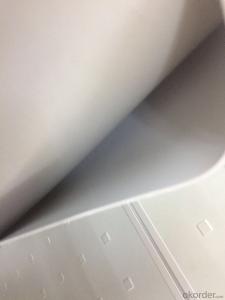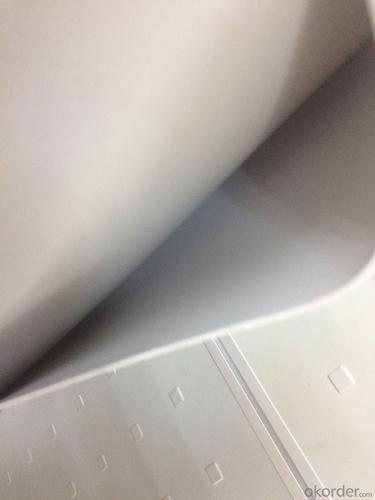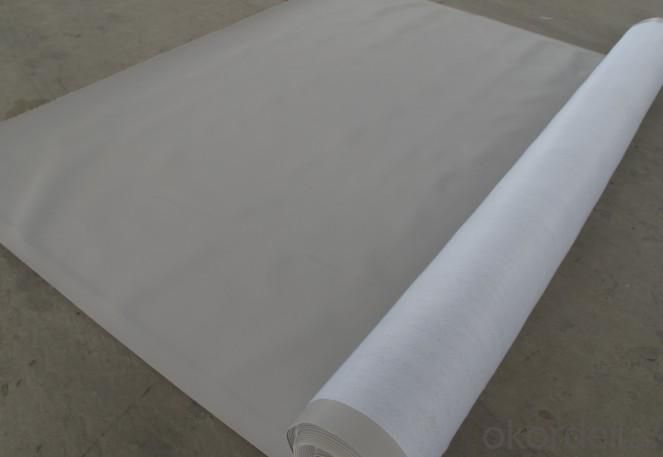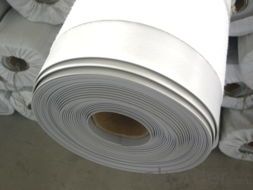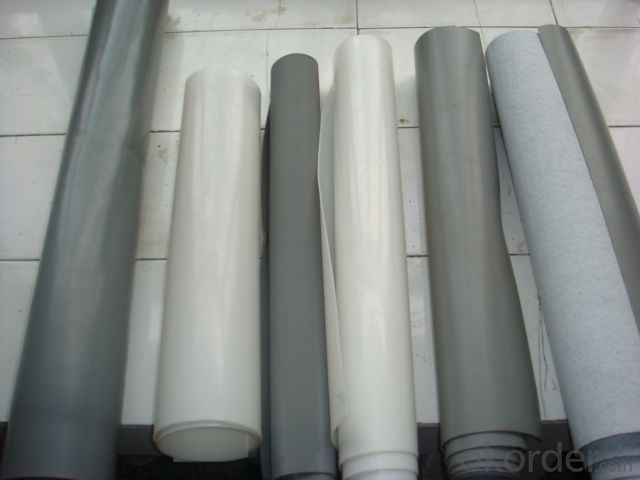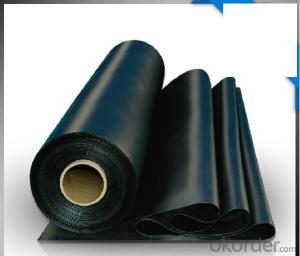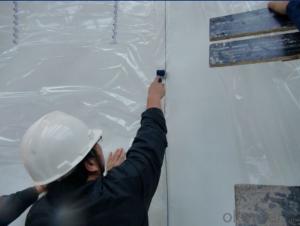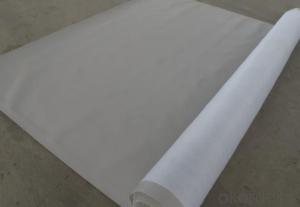PVC Waterproof Roofing Membrane Thickness with 1.5 mm
- Loading Port:
- Qingdao
- Payment Terms:
- TT OR LC
- Min Order Qty:
- 5000 m²
- Supply Capability:
- 10000 m²/month
OKorder Service Pledge
OKorder Financial Service
You Might Also Like
PVC Waterproof Membrane Description:
PVC waterproof membrane is an excellent high quality polymer waterproof sheet, made of PVC resin by adding plasticizer, anti-UV agent, anti aging agent, and stabilizer and other processing aids through extrusion and molding.As the highly recommended product by the Ministry of Construction, it is featured by high tensile strength, great elongation, good stability, small shrinkage, low temperature performances, good resistance to weathering and root penetration, and long service life.
PVC Waterproof Membrane Main Features:
1.Good combination of high elasticity and tensile strength.
2.Fine resistance to static electricity.
3.Excellent resistance to ageing / weathering.
4.Durable,the effective age can be more than 20 years used on exposed surfaces,used on non-exposed surfaces,it can reach 50 years.
5.Fine flexibility at low temperature,adaptable to cold conditions.
6.Root-resistance,can be used on the planting roofs.
7.Fine puncture resistance, joint peel strength and joint shear strength.
8.Fine UV-resistance,no pollution to environment.
9.Easily welding,installing,secure.
10.Easy treatments to the delicate parts of corners and edges.
11.Convenient maintenance with low cost.
Polyvinyl Chloride (PVC) membrane with fiber reinforced layer on the back is widely used in the roofs of civil buildings, tunnels, channels,
FAQ:
Q: Can I visit your company?
A: Yes, welcome to visit our enterprise.
Q: Can I do the third party testing before loading?
A: Yes, we could accept the third party testing.
Q: Which kind of payment in your company?
A: We could accept TT, LC at sight, etc.
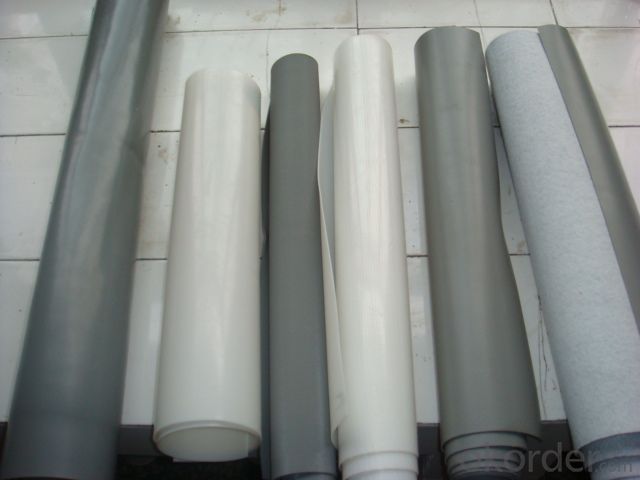
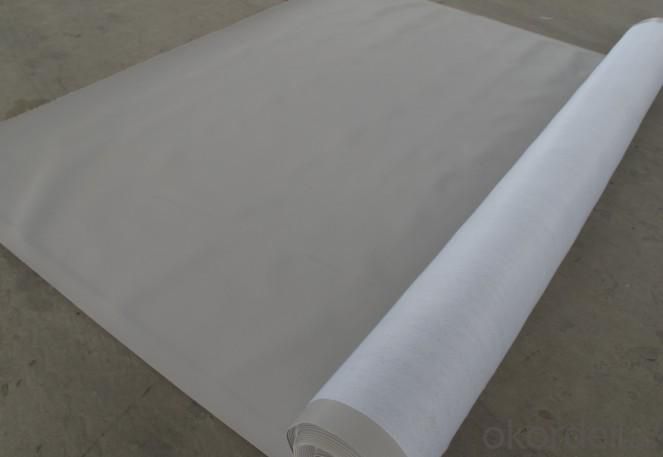
- Q: Are there any specific installation requirements for waterproofing membranes?
- Waterproofing membranes have specific installation requirements that vary depending on the type of membrane. However, there are some general guidelines that apply to most installations. To begin, it is crucial to adequately prepare the surface where the membrane will be applied. This involves cleaning the surface, removing any loose debris or previous coatings, and ensuring it is smooth and free from irregularities. Proper surface preparation allows for better adhesion between the membrane and the surface. Following that, the membrane should be applied in accordance with the manufacturer's instructions. This typically involves using a suitable adhesive or bonding agent to attach the membrane to the surface. It is important to adhere to the recommended application rate and ensure a uniform application without air bubbles or wrinkles. In addition to correct application, special attention should be given to the seams and joints of the membrane. These areas are particularly vulnerable to water penetration, so they need to be carefully sealed using an appropriate sealant or tape. This guarantees a watertight seal and prevents any water from seeping through the seams. Lastly, it is essential to safeguard the installed membrane from damage during and after installation. This can be achieved by covering the membrane with a protective layer, such as geotextile fabric or a layer of soil, to prevent punctures or tears. Additionally, any construction or landscaping work following the installation should be done cautiously to avoid harming the membrane. Ultimately, the specific installation requirements for waterproofing membranes depend on the type of membrane and the project's specific conditions. It is always advisable to consult the manufacturer's instructions and guidelines to ensure proper installation and long-lasting waterproofing performance.
- Q: Can waterproofing membranes be applied over existing surfaces?
- Yes, waterproofing membranes can be applied over existing surfaces. In fact, this is a common practice in construction and renovation projects. Waterproofing membranes are designed to provide a protective barrier against water infiltration, and they can be applied over various surfaces such as concrete, wood, metal, or even other waterproofing systems. By applying a waterproofing membrane over an existing surface, it helps to prevent water damage, including leaks, mold growth, and structural deterioration. However, it is important to ensure that the existing surface is properly prepared and cleaned before the membrane application to achieve optimal adhesion and performance. Additionally, it is recommended to consult with a professional waterproofing contractor to determine the most suitable membrane type and installation method for the specific project requirements.
- Q: How does a waterproofing membrane handle exposure to UV rays and sunlight?
- Various mechanisms are employed in the design of a waterproofing membrane to withstand exposure to UV rays and sunlight. Firstly, UV stabilizers and additives are incorporated into most waterproofing membranes to shield the material from the harmful effects of prolonged UV radiation. These stabilizers effectively prevent the membrane from deteriorating and breaking down when exposed to sunlight. In addition, many waterproofing membranes are manufactured with reflective pigments or coatings that assist in reflecting a significant portion of the sun's rays. This reflective quality reduces the absorption of UV radiation, minimizing heat absorption by the membrane. Consequently, the membrane remains cooler, bolstering its durability and extending its lifespan. Furthermore, certain waterproofing membranes are reinforced with materials like fiberglass or polyester to provide extra strength and resistance against UV rays. These reinforcing materials act as a barrier, safeguarding the membrane from direct exposure to sunlight and diminishing the risk of sun damage. It should be noted that although waterproofing membranes are designed to withstand UV exposure, their performance can be influenced by factors such as the intensity and duration of sunlight exposure, climate conditions, and maintenance practices. Regular inspections and maintenance, including the application of UV protective coatings or sealants, can aid in prolonging the life and effectiveness of the waterproofing membrane in areas with high UV exposure. Ultimately, a well-designed and correctly installed waterproofing membrane is engineered to endure UV rays and sunlight, ensuring long-term protection and durability for the underlying structure.
- Q: Can a waterproofing membrane be used for a parking garage deck protection?
- Indeed, the utilization of a waterproofing membrane is a viable option for safeguarding the parking garage deck. Designed with the specific purpose of preventing water infiltration and shielding the underlying structure from moisture-related harm, a waterproofing membrane proves to be highly effective in such scenarios. When applied to the parking garage deck, the waterproofing membrane acts as a barrier, effectively preventing water from permeating the concrete and reaching the steel reinforcement beneath. This, in turn, mitigates the risk of corrosion and deterioration, ultimately prolonging the lifespan of the structure and minimizing the need for expensive repairs or replacements. Moreover, the waterproofing membrane offers protection against other potential sources of damage, including oil or chemical spills resulting from vehicular activity. By creating a barrier, it successfully hinders these substances from penetrating the concrete and causing unsightly stains or deterioration. Supplementary to its protective capabilities, the waterproofing membrane enhances the overall durability and strength of the parking garage deck. It aids in the reduction of cracking, spalling, and other forms of concrete damage that may arise due to freeze-thaw cycles, temperature fluctuations, or heavy loads. All in all, opting for a waterproofing membrane to safeguard the parking garage deck is a highly recommended solution for ensuring the longevity and structural integrity of the facility. By providing a dependable defense against water infiltration, chemical spills, and other potential sources of damage, it serves to decrease maintenance expenses and extend the lifespan of the parking garage deck.
- Q: Can a waterproofing membrane be used for docks or marinas?
- Yes, a waterproofing membrane can indeed be used for docks or marinas. Waterproofing membranes are commonly used in construction to provide a barrier against water penetration. In the case of docks or marinas, where constant exposure to water is expected, a waterproofing membrane can be a valuable solution to protect the structure from water damage. Waterproofing membranes are typically made from materials such as rubber, PVC, or modified bitumen. These materials are designed to withstand water pressure and prevent water from seeping into the structure. They are applied as a continuous layer over the surface, creating a watertight seal. By installing a waterproofing membrane on docks or marinas, it helps to prevent water from penetrating the structure, which can result in damage over time. Water damage can lead to structural deterioration, rotting of wood, corrosion of metal components, and the growth of mold or mildew. Additionally, a waterproofing membrane can also provide protection against other elements such as UV rays, chemicals, and oil spills. It is important to ensure that the chosen waterproofing membrane is specifically designed for use in marine environments. This ensures that it can withstand the unique challenges posed by saltwater, fluctuating water levels, and the constant exposure to waves and tides. Additionally, it is crucial to follow proper installation procedures and maintenance guidelines to ensure the longevity and effectiveness of the waterproofing membrane. In summary, a waterproofing membrane can be a suitable solution for docks or marinas to protect them from water damage. It provides a reliable barrier against water penetration, helping to extend the lifespan of the structure and minimize maintenance requirements.
- Q: Can a waterproofing membrane be used for theme parks or amusement centers?
- Yes, a waterproofing membrane can be used for theme parks or amusement centers. These types of facilities often have water features, pools, or water rides that require effective waterproofing to prevent leaks or water damage. Waterproofing membranes provide a reliable and durable solution to keep these areas watertight, ensuring the safety and longevity of the park or center.
- Q: Are waterproofing membranes suitable for exterior use?
- Yes, waterproofing membranes are suitable for exterior use. They are designed to provide a protective barrier against water infiltration and can be applied to various exterior surfaces such as roofs, foundations, and walls. Waterproofing membranes are effective in preventing water damage and maintaining the integrity and longevity of the structure.
- Q: Is a waterproofing membrane resistant to punctures or tears?
- A waterproofing membrane is created to resist punctures or tears, being made from robust materials like PVC, TPO, or EPDM, renowned for their strength and damage resistance. These membranes undergo extensive testing to ensure they can endure different environmental conditions and potential causes of punctures or tears, like sharp objects or heavy foot traffic. Some waterproofing membranes even have reinforcement layers or added protection to further strengthen their resistance to punctures and tears. Nevertheless, it is crucial to note that while waterproofing membranes are highly durable, they are not entirely immune to damage. Proper installation, regular maintenance, and avoiding unnecessary stress or impact on the membrane can help extend its lifespan and enhance its performance.
- Q: Can waterproofing membranes be used on elevator pits?
- Yes, waterproofing membranes can be used on elevator pits. Elevator pits are prone to water infiltration due to their location below ground level, making them susceptible to water damage and leaks. Waterproofing membranes provide an effective solution to prevent water penetration and protect elevator pits from moisture-related issues. These membranes are designed to create a watertight barrier, usually made of materials such as rubber, polyurethane, or bitumen. They are applied to the walls and floor of the elevator pit, forming a seamless and durable protective layer. This membrane system helps to keep the pit dry, preventing water damage to the elevator components and ensuring the safe and reliable operation of the elevator.
- Q: What is called a waterproof roll dry shop, wet shop
- Dry shop, wet shop is said self-adhesive coil. Dry shop is in the formation of the grass on the first layer of primary treatment agent, and then paving self-adhesive coil method is the easiest and fastest way.
Send your message to us
PVC Waterproof Roofing Membrane Thickness with 1.5 mm
- Loading Port:
- Qingdao
- Payment Terms:
- TT OR LC
- Min Order Qty:
- 5000 m²
- Supply Capability:
- 10000 m²/month
OKorder Service Pledge
OKorder Financial Service
Similar products
Hot products
Hot Searches
Related keywords
